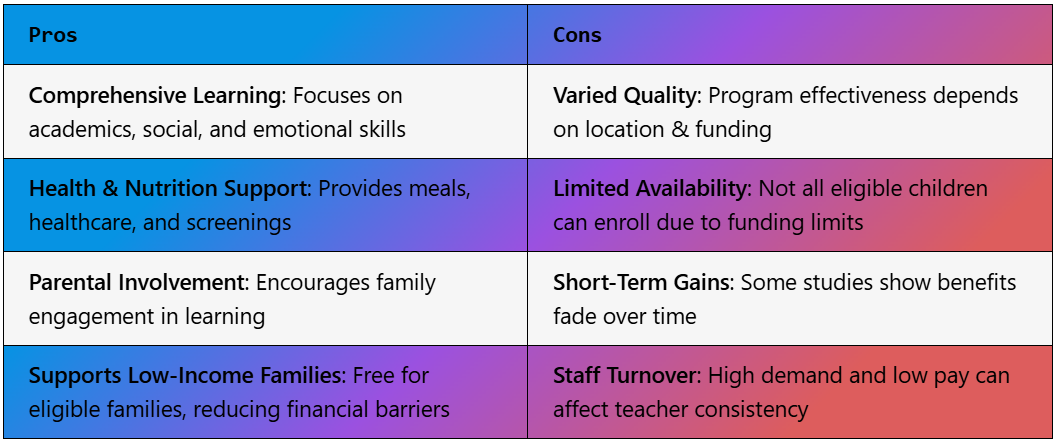The Head Start Curriculum is a comprehensive framework designed to support the development of young learners in their crucial early years. This curriculum emphasizes a holistic approach to education, focusing not just on academic skills but also on social, emotional, and physical development.
By integrating various learning styles and activities, the Head Start Curriculum ensures that each child receives a well-rounded educational experience that prepares them for future success in school and beyond. One of the standout features of the Head Start Curriculum is its commitment to play-based learning activities. These activities are not just fun; they are essential for fostering creativity, critical thinking, and problem-solving skills.
For instance, children might engage in role-playing scenarios that encourage them to explore different social roles, or they might participate in hands-on science experiments that spark their curiosity about the world around them. This approach allows children to learn at their own pace while developing essential life skills. Here are some key benefits of the Head Start Curriculum for early childhood education:
- Holistic Development: Addresses cognitive, social, and emotional growth.
- Individualized Learning: Tailors activities to meet the unique needs of each child.
- Family Engagement: Encourages parental involvement, fostering a supportive learning environment.
- Community Resources: Connects families with local services to enhance educational opportunities.
By focusing on these areas, the Head Start Curriculum not only prepares children for academic success but also equips them with the tools they need to thrive in their everyday lives.
Contact Now to Pursue Your Dream Degree From Your Nearest College
Key Components of the Head Start Curriculum Framework
The Head Start Curriculum Framework is crafted to offer young learners a rich and engaging educational experience, emphasizing holistic development. This approach ensures that children acquire not only academic skills but also vital social and emotional competencies.
By integrating various learning methods, particularly play-based learning activities, the curriculum nurtures a lifelong love for learning. For example, hands-on activities encourage children to explore their environment, fostering curiosity and creativity while enhancing critical thinking skills. A key feature of the Head Start Curriculum is its commitment to individualized learning.
Recognizing that each child is unique, the curriculum provides tailored activities that accommodate different learning styles and paces. Here are some essential components that contribute to its effectiveness:
- Comprehensive Development: Focuses on cognitive, social, emotional, and physical growth.
- Family Engagement: Actively involves families in the educational process, creating a supportive home environment.
- Culturally Responsive Practices: Acknowledges and incorporates the diverse backgrounds of children, making learning relevant.
- Assessment and Feedback: Regular assessments enable educators to monitor progress and adapt teaching methods accordingly.
Play-based learning activities are crucial to the Head Start Curriculum, making education enjoyable while helping children develop essential skills like teamwork, problem-solving, and communication. For instance, a simple building blocks game can teach shapes and balance while promoting peer collaboration. Overall, the Head Start Curriculum Framework lays a strong foundation for young learners, equipping them with the necessary tools to thrive in school and beyond, ultimately fostering a nurturing environment for lifelong success.
How the Head Start Curriculum Supports Social and Emotional Development
The Head Start Curriculum adopts a holistic approach that emphasizes the social and emotional development of young learners. Recognizing that emotional well-being is as vital as cognitive skills, this curriculum integrates play-based learning activities that encourage children to express their feelings, build relationships, and develop empathy.
For example, during group activities, children learn essential skills such as sharing, taking turns, and resolving conflicts, which are crucial for their future interactions. A key feature of the Head Start Curriculum is its commitment to creating a nurturing environment. Educators are trained to build positive relationships with children, ensuring they feel safe and valued. This supportive atmosphere allows children to explore their emotions freely. Here are some benefits of this approach:
- Enhanced Emotional Intelligence: Children learn to identify and manage their emotions.
- Improved Social Skills: Collaborative play fosters cooperation and communication.
- Increased Self-Confidence: Navigating social situations boosts children’s confidence in interacting with peers.
For instance, in a role-playing activity, children might act out various community roles, such as a doctor or teacher. This not only sparks their imagination but also helps them understand different perspectives. Such play-based learning is fundamental in the Head Start Curriculum, laying the groundwork for emotional resilience and social competence. By focusing on these areas, the curriculum prepares children for academic success and equips them with essential tools for thriving in their personal lives.
Cognitive Skills Development in the Head Start Curriculum
The Head Start Curriculum is crafted to enhance cognitive skills development in young learners, laying a strong foundation for their educational futures. This curriculum adopts a holistic approach to early childhood education, accommodating various learning styles and developmental needs.
Through engaging play-based learning activities, children are encouraged to explore and discover, which not only boosts their cognitive abilities but also fosters creativity and critical thinking skills. A key feature of the Head Start Curriculum is its emphasis on interactive learning. Children participate in activities that promote problem-solving and decision-making.
For example, during a group project, they might collaborate to build a structure with blocks, learning about spatial awareness and engineering while also developing teamwork and communication skills. Some benefits of this approach include:
- Enhanced critical thinking: Children learn to analyze situations and devise solutions.
- Improved social skills: Collaborative tasks teach the value of working with others.
- Increased engagement: Play-based activities keep children motivated and interested in learning.
Additionally, the Head Start Curriculum weaves various subjects like math, science, and literacy into its play-based framework. For instance, while playing with water, children can grasp concepts of volume and measurement, making math relatable. This integration of learning through play not only makes education enjoyable but also ensures that children develop essential cognitive skills in a nurturing environment. Ultimately, the Head Start Curriculum equips young learners for academic success while instilling a lifelong love for learning.
The Role of Family Engagement in the Head Start Curriculum
The Head Start Curriculum is designed to provide a comprehensive foundation for young learners, and one of its most vital components is family engagement. When families actively participate in their child’s education, it creates a supportive environment that enhances learning outcomes. This collaboration between educators and families fosters a sense of community and ensures that children feel secure and valued, which is essential for their development.
Family engagement in the Head Start Curriculum can take many forms. For instance, parents might attend workshops that teach them about early childhood education principles or participate in play-based learning activities alongside their children. These experiences not only strengthen the bond between parent and child but also empower parents with the tools they need to support their child’s learning at home. Here are some key benefits of family engagement in this curriculum:
- Enhanced Learning: Children whose families are involved tend to perform better academically and socially.
- Stronger Relationships: Engagement fosters trust and communication between families and educators.
- Cultural Relevance: Families can share their unique backgrounds, enriching the curriculum and making it more relatable for children.
- Supportive Environment: A collaborative approach creates a nurturing atmosphere that promotes emotional well-being.
- Skill Development: Parents learn effective strategies to support their child’s growth, from literacy to social skills.
By prioritizing family engagement, the Head Start Curriculum not only supports early childhood education but also builds a strong foundation for lifelong learning.
Contact Now to Pursue Your Dream Degree From Your Nearest College
Tailoring the Head Start Curriculum to Diverse Learning Needs
The Head Start Curriculum recognizes that each child is unique, with individual strengths and challenges. It adopts a holistic approach to early childhood education, emphasizing not only academic skills but also social, emotional, and physical development. By tailoring the curriculum to diverse learning needs, educators can create a nurturing environment where all children can thrive.
For example, children who find traditional learning methods challenging can engage in play-based learning activities that make education enjoyable and effective. A significant feature of the Head Start Curriculum is its flexibility. Educators are encouraged to adapt lessons to accommodate the varying developmental stages and interests of their students. This can include:
- Using visual aids and interactive materials for visual learners.
- Engaging auditory learners through storytelling and role-play.
- Offering sensory activities for kinesthetic learners.
By acknowledging these differences, teachers can cultivate an inclusive classroom that fosters participation and enthusiasm among all children. Additionally, the Head Start Curriculum highlights the importance of family involvement in the learning process. Engaged families contribute to children’s success, and programs often provide workshops and resources to help parents support their child’s learning at home.
This collaboration enhances the educational experience and builds a strong community around each child, reinforcing the idea that learning is a shared journey. Ultimately, the Head Start Curriculum offers a comprehensive framework that adapts to the diverse needs of young learners, ensuring every child has the opportunity to shine.

Assessment Strategies in the Head Start Curriculum
The Head Start Curriculum is designed to provide a comprehensive foundation for young learners, focusing on their holistic development. One of the key components of this curriculum is its emphasis on assessment strategies that are both effective and engaging. These strategies are not just about testing knowledge; they are about understanding each child’s unique learning journey.
By incorporating play-based learning activities, educators can observe children in natural settings, allowing for a more accurate assessment of their skills and abilities. Here are some of the benefits of the assessment strategies used in the Head Start Curriculum:
- Holistic Development: Assessments consider emotional, social, cognitive, and physical growth.
- Individualized Learning: Teachers can tailor activities to meet the specific needs of each child.
- Engagement: Play-based assessments keep children interested and motivated, making learning fun.
- Family Involvement: Parents are encouraged to participate in the assessment process, fostering a supportive learning environment at home.
In practice, educators might use observations during playtime to assess a child’s problem-solving skills or social interactions. For instance, if a child is building a block tower, the teacher can note how they collaborate with peers or handle challenges.
This real-world application of assessment not only provides valuable insights into a child’s development but also reinforces the idea that learning happens everywhere, not just in a classroom setting. Overall, the Head Start Curriculum’s assessment strategies are designed to nurture young learners, ensuring they are ready for future educational experiences.
Benefits of the Head Start Curriculum for Lifelong Learning
The Head Start Curriculum is crafted to provide young learners with a robust foundation for lifelong learning, emphasizing the significance of early childhood education and the holistic development of children. By incorporating various learning styles and activities, the curriculum fosters a supportive environment where each child can thrive.
Through play-based learning activities, children engage with peers while developing critical thinking and problem-solving skills essential for their future. A key benefit of the Head Start Curriculum is its focus on social and emotional development. Children learn to express their feelings, build relationships, and navigate social situations, skills that are often linked to later academic success. Here are some notable benefits of the Head Start Curriculum for young learners:
- Enhanced Cognitive Skills: Engaging activities stimulate curiosity and creativity.
- Improved Social Skills: Collaborative play fosters teamwork and communication.
- Cultural Awareness: Exposure to diverse backgrounds promotes inclusivity and respect.
- Family Engagement: Involving families in the learning process strengthens community ties and support systems.
Additionally, the Head Start Curriculum is adaptable, catering to the unique needs of each child. Educators are trained to recognize individual learning styles and adjust their teaching methods accordingly. This personalized approach not only boosts confidence but also fosters a lifelong love for learning. By establishing this groundwork, the Head Start program prepares children for school and instills a passion for exploration and discovery that benefits them in all areas of life.
Contact Now to Pursue Your Dream Degree From Your Nearest College
FAQs
-
What is the Head Start Curriculum?
The Head Start Curriculum is a research-based, developmentally appropriate program designed to support school readiness in young children from low-income families. -
What are the key components of the Head Start Curriculum?
It includes areas such as language and literacy, math, social-emotional development, physical development, and approaches to learning. -
Is the Head Start Curriculum the same nationwide?
No, Head Start programs can choose from various approved curricula, but they all align with the Head Start Early Learning Outcomes Framework (ELOF). -
What age group does the Head Start Curriculum serve?
It serves children from birth to age five, including infants, toddlers, and preschoolers.


